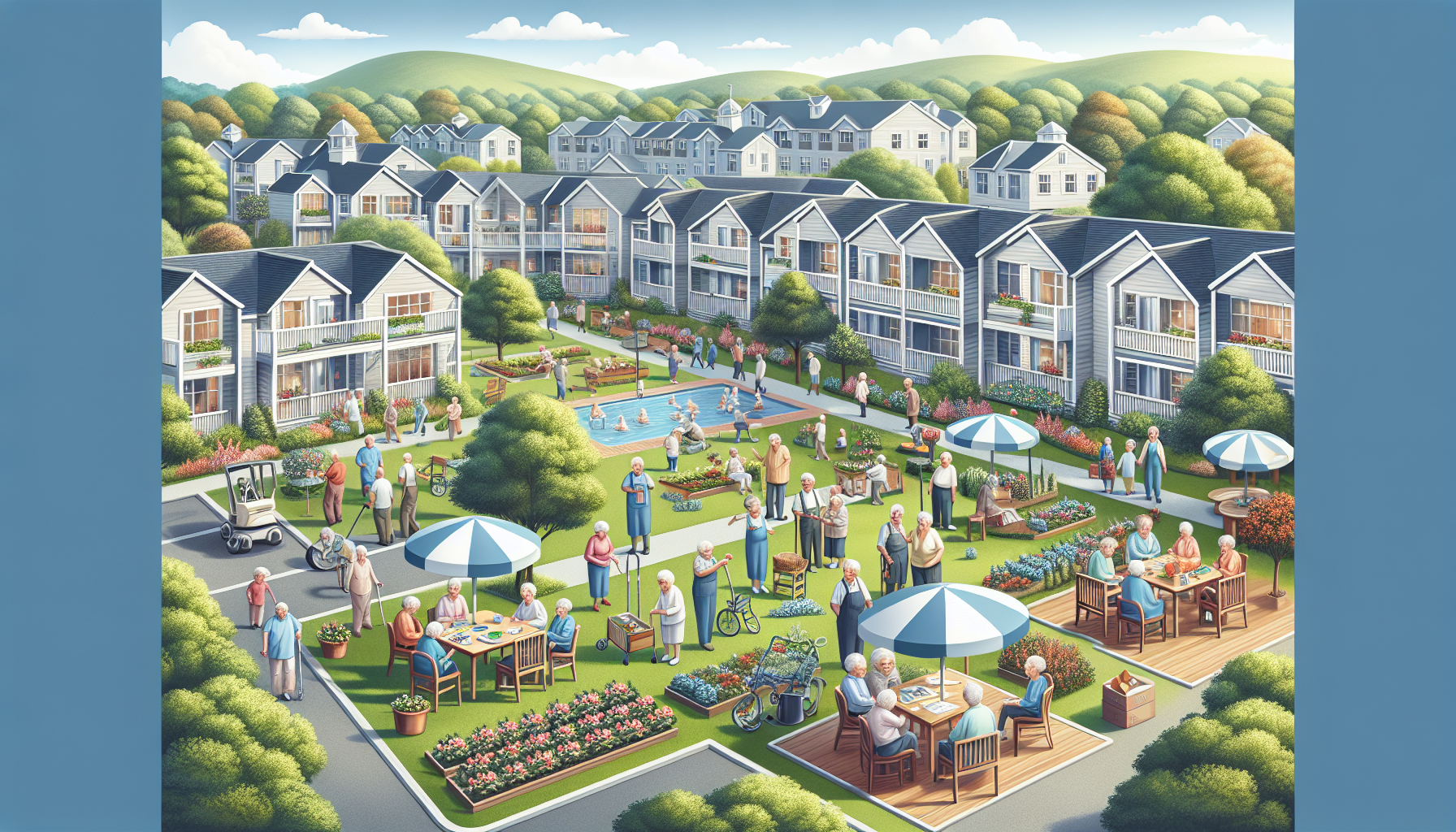Find your perfect retirement independent living communities with our guide to amenities, costs, and more.
February 26, 2025

As people age, their lifestyle needs and preferences change, often leading them to consider options like retirement independent living communities. Understanding what independent living entails can help individuals and their families make informed decisions that align with their goals for a vibrant, active, and fulfilling retirement.

Independent living refers to housing designed exclusively for older adults, generally those aged 55 and over. These communities can range from apartment-style living to single-family detached homes, designed with the needs and preferences of seniors in mind. The primary goal of independent living is to preserve independence and eliminate the stresses of maintenance and upkeep associated with traditional homes, while still providing avenues for community, activity, and relaxation.
Residents of these communities maintain privacy and control over their own lives, with the added benefits of amenities and services that make life easier. Importantly, while medical care or nursing staff is generally not provided in these communities, residents can hire in-home help separately if needed.
Retirement independent living communities offer a wide range of amenities to support an active and social lifestyle. Similar to high-quality hotels, these communities may include onsite facilities such as a swimming pool, fitness center, and tennis courts. Other services could include onsite spas, beauty and barber salons, daily meals, and basic housekeeping and laundry services [1].
In addition to these standard amenities, some retirement communities specialize in the treatment of illnesses like dementia and diabetes, offering unique amenities different from standard retirement communities.
These amenities not only encourage social interaction and physical activity but also contribute to community-building among residents. This fosters an environment that supports healthy aging while providing opportunities for residents to lead an engaging and fulfilling lifestyle [2].
In conclusion, independent living communities provide older adults with the opportunity to enjoy a stress-free, maintenance-free lifestyle, while still preserving their independence and providing opportunities for social interaction and physical activity. The right independent living community can truly elevate one's retirement years, providing a comfortable, stimulating, and rewarding environment for seniors.

When considering retirement independent living communities, there are various types to explore to find the best fit. Two of the most common types are Continuing Care Retirement Communities (CCRCs) and Low-Income or Subsidized Senior Housing.
Continuing Care Retirement Communities (CCRCs), also known as Life Plan Communities, offer a spectrum of care from independent living to nursing home care within the same community. This model allows residents to transition to higher levels of care as their needs change, providing a continuum of care throughout their retirement years.
One of the unique aspects of CCRCs is the pricing model. In most of these communities, independent living residents pay an entrance fee (usually 75 to 90 percent refundable) and a monthly fee covering maintenance, housekeeping, security, some meals, and programming. If a resident requires assisted living, the community operates under a rental model with monthly fees that include various services like housekeeping, security, nursing observation, meals, and 24/7 staffing.
CCRCs are an excellent choice for those who value the security of having access to a full spectrum of care options within one community, allowing for peace of mind and continuity of care as one's needs evolve.
For those on a limited income, Low-Income or Subsidized Senior Housing options are available in the United States. These housing complexes are subsidized by the US Department of Housing and Urban Development (HUD), making them more affordable for seniors who meet the income eligibility requirements.
These communities typically provide basic amenities and may also offer some services and activities for residents. However, they may not offer the same level of care or range of amenities as other types of retirement communities.
It's important to research and understand the eligibility requirements and application process for these housing options. Assistance from a social worker or elder care advocate may be beneficial in navigating these options.
Choosing the right retirement community is a personal decision that should take into consideration one's care needs, financial situation, and lifestyle preferences. By understanding the different types of communities available, one can make an informed decision about their retirement living options.

When looking into retirement independent living communities, there are some critical aspects to consider. These include location and convenience, amenities and services provided, and the cost and pricing options available.
Location is a critical factor when selecting a senior living community. It affects convenience, accessibility, safety, and the overall lifestyle of the residents. Factors like proximity to loved ones, walkability, and the surrounding town should be taken into account when making a decision. A good location enhances the quality of life, makes it easier for family visits, and provides easy access to amenities like shops, parks, and healthcare facilities [5].
The amenities and services provided by retirement communities play a significant role in shaping the living experience. Factors to consider include dining services, opportunities for exercise and entertainment in the neighborhood, on-site amenities such as hair salons and libraries, and wellness options like yoga and swimming pools.
Other considerations include pet policies, availability of help, transportation options, activities of interest, and family visitation policies. These features contribute to a comfortable and enriching lifestyle. The community should also foster good relationships among residents, promoting a sense of belonging and community.
The cost of living in a retirement community can vary greatly, depending on factors such as size, location, type of community, and amenities. On average, monthly fees for retirement communities in Canada range from $1,600 to $6,270.
| Province | Average Monthly Cost |
|---|---|
| Ontario | $1,600 - $6,270 |
| Quebec | $1,520 |
| Alberta | $2,855 |
| British Columbia | $2,785 |
The costs vary across different provinces, with Ontario having the widest range of costs and Quebec having the lowest average rent. In Alberta, the average monthly rent for seniors is $2,855, while in British Columbia, it's $2,785 [7].
These costs often take into account the provision of health care and other amenities in the residences. As such, it's essential to understand what the monthly fees cover and whether there are additional costs for specific services or care options.
Considering these factors will help in making an informed decision when choosing the best independent living community for retirement.
An essential component of retirement independent living communities is the vibrant social life and a plethora of activities available for residents. These aspects contribute significantly to the quality of life and overall well-being of the seniors living in these communities.
Building social connections and fostering a sense of community is a key feature of retirement communities. Social hours are typically held for residents to meet and interact, fostering social connections, and enabling residents to engage with others who share similar interests. Socializing is a key component of the amenities provided to enhance the overall well-being of residents.
Moreover, many retirement communities are pet-friendly, which can provide additional opportunities for social interaction and companionship. While rules about the number and types of pets may apply, the independent living space in these communities allows for pet ownership.
Retirement communities are not only about leisure; they also put a strong emphasis on the physical fitness and wellness of their residents. Assisted living communities aim to make fitness fun and easily accessible through on-site gyms and a variety of activities. They are increasingly offering mindfulness-supporting activities alongside fitness opportunities [8].
Popular activities like dance sessions help maintain physical fitness and also provide an excellent social opportunity for seniors. Participating in such mentally and physically stimulating activities can lead to health benefits such as staving off memory loss and improving overall well-being.
Retirement communities offer a wide variety of recreational activities and events to keep their residents engaged and entertained. Music activities, including karaoke and competitions like "American Idol," are common and beneficial for the mind. Music therapy is gaining popularity in memory care communities as well.
These communities also organize special events like carnivals, senior proms, and screenings, providing residents with engaging and enjoyable experiences beyond daily routines.
In conclusion, the availability of diverse social, recreational, and wellness activities is a crucial factor to consider when choosing between retirement independent living communities. These aspects significantly contribute to the quality of life, overall well-being, and satisfaction of the residents in these communities.
When it comes to retirement communities, it's essential to understand the differences between independent living and assisted living. Both options provide advantages depending on the individual's needs, health status, and lifestyle preferences.
Independent living communities are typically age-restricted (typically 55+) apartment complexes with additional conveniences for seniors. Residents in independent living communities are self-sufficient and do not require hands-on care. Independent living communities usually provide organized activities, meal plans, and transportation services, and may offer housekeeping and errand services. Some of these communities also offer independent home care services, which can be beneficial for seniors needing additional help for a scheduled medical procedure or a short period without being ready for a move to assisted living.
On the other hand, assisted living facilities offer a higher level of care, including help with daily activities such as bathing, dressing, and medication management. Assisted living is a suitable option for seniors who require assistance with these daily tasks but do not need the comprehensive care provided in a nursing home.
Independent living communities focus on amenities that enhance quality of life in aspects such as physical health, social life, emotional wellness, spiritual life, intellect, and creativity [10]. These communities provide a place for seniors to live on their own, similar to being in their own homes, with amenities and services such as full-service dining rooms to enhance their lifestyle.
In contrast, assisted living communities also offer a range of amenities, but with a greater emphasis on providing care and support. These communities typically have on-site medical staff and offer services like medication management, physical therapy, and personal care services.
When considering independent living vs. assisted living, it's essential to think about the level of care required, the desired lifestyle, and which type of community best suits the individual's needs and preferences.
When choosing the best independent living communities, seniors need to consider their personal preferences, family involvement, and decision-making process.
Seniors are encouraged to stay true to their personal interests and wishes when choosing an independent living community. The chosen community should align with their lifestyle and long-term goals, ensuring the available amenities and services will enhance their quality of life Amavida Living.
Factors to consider include dining services, opportunities for exercise and entertainment in the neighborhood, on-site amenities such as hair salons and libraries, exercise and wellness options like yoga and swimming pools, pet policies, help availability, transportation options, activities of interest, family visitation policies, costs, and relationships within the community Arbor Company Blog.
For active seniors, communities that offer assisted living options may provide peace of mind in case they require assistance in the future Arbor Company Blog.
The level of family involvement can vary depending on the type of community. In independent living, families are encouraged to engage with the community, but the primary decision-making lies with the resident Hebrew SeniorLife. Family members tend to have more involvement in the care of loved ones in assisted living communities, especially those with dementia. They are usually kept informed about their loved one's progress and are part of the care planning process.
The decision-making process when choosing retirement independent living communities involves evaluating various factors like location, cost, amenities, services, and the level of care provided. Independent living facilities are more suitable for older adults who require less assistance or medical care Hebrew SeniorLife.
Both independent and assisted living communities offer various programming and amenities including private apartments, housekeeping, 24-hour staff, transportation, events, social opportunities, and dining options Hebrew SeniorLife. Assisted living communities may provide more tailored programming, especially for memory care, along with more hours of activities per day.
In conclusion, the best community for an individual will depend on their specific needs, preferences, and lifestyle. By considering all these factors, seniors and their families can make an informed decision that ensures a comfortable and satisfying retirement.
[1]: https://www.helpguide.org/articles/senior-housing/independent-living-for-seniors.htm
[2]: https://www.seniorliving.org/care/amenities/
[3]: https://www.aplaceformom.com/caregiver-resources/articles/continuing-care-retirement-communities
[4]: https://www.hebrewseniorlife.org/blog/five-differences-between-independent-living-and-assisted-living
[5]: https://www.humangood.org/resources/senior-living-blog/choosing-senior-living-community-next-home
[6]: https://www.arborcompany.com/blog/11-factors-to-consider-when-choosing-a-retirement-community
[7]: https://www.comfortlife.ca/retirement-community-resources/retirement-cost
[8]: https://www.aplaceformom.com/caregiver-resources/articles/assisted-living-activities
[9]: https://www.aplaceformom.com/caregiver-resources/articles/assisted-living-vs-independent-living
[10]: https://www.amavidaliving.com/news/item/1516210303-top-amenities-look-when-choosing-independent-living-community
09:00 AM - 06:00 PM
Monday - Friday
2488 Grand Concourse Suite 409, Bronx, NY, 10458
T: 718-305-5858
F: 718-305-6258
1 Smith Street, 3rd Floor, Brooklyn, New York, 11201
T: 718-305-5959
F: 718-305-6259
2361 Nostrand Ave Suite 401 Brooklyn, NY 11210.
T: 718-305-6060
F: 718-305-6260
576 Central Ave # 301, East Orange, NJ 07018
433 Woodbury Glassboro Road Sewell, NJ 08080
1172 Fischer Blvd, Toms River, NJ 08753
T: (973) 678-5500
njinfo@h2hhc.com








